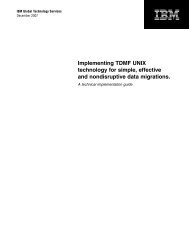The evolving role of the CIO - IBM
The evolving role of the CIO - IBM
The evolving role of the CIO - IBM
Create successful ePaper yourself
Turn your PDF publications into a flip-book with our unique Google optimized e-Paper software.
<strong>The</strong> <strong>CIO</strong>, can expect in turn to be dealing with an individual<br />
who fully understands <strong>the</strong> potential <strong>of</strong> IT. <strong>The</strong> CEO may not<br />
appreciate all <strong>the</strong> detailed possibilities, but will be aware<br />
<strong>of</strong> <strong>the</strong> wide range <strong>of</strong> business benefits IT can bring. <strong>The</strong><br />
<strong>CIO</strong> no longer has to sell <strong>the</strong> IT philosophy – and at <strong>the</strong><br />
same time, he knows that his or her business acumen,<br />
commercial skills, and strategic awareness are valued<br />
at <strong>the</strong> highest level.<br />
<strong>The</strong> destination<br />
Many <strong>CIO</strong>s and many organisations, as we have already<br />
seen, are already well on <strong>the</strong>ir way on <strong>the</strong> journey.<br />
<strong>The</strong> organisations have undergone radical change –<br />
becoming more organic, less hierarchical, and defined<br />
more by process than by functional activity – and <strong>the</strong><br />
<strong>CIO</strong> has changed with <strong>the</strong>m. In a modern organisation,<br />
no-one stands still. Business as usual is not an option:<br />
it has to be activity on demand.<br />
But how will <strong>the</strong> <strong>role</strong> continue to evolve? <strong>The</strong>re are some<br />
changes that are already under way.<br />
• Keeping <strong>the</strong> business running<br />
Tomorrow, <strong>the</strong> <strong>CIO</strong>’s <strong>role</strong> will be much wider than it is today.<br />
In <strong>the</strong> past, it might have been little more than ‘keeping <strong>the</strong><br />
lights on’, but <strong>the</strong> business element <strong>of</strong> <strong>the</strong> job description<br />
which might be written for today’s <strong>CIO</strong> can only get bigger,<br />
as IT reaches into every corner <strong>of</strong> every work location across<br />
<strong>the</strong> organisation.<br />
Moves towards shared service provision, ei<strong>the</strong>r internally<br />
or with third parties, which have increased dramatically in<br />
<strong>the</strong> last few years, will mean that <strong>the</strong> <strong>CIO</strong> will be responsible<br />
for <strong>the</strong> additional provision <strong>of</strong> business process services,<br />
sourcing <strong>of</strong> business process, IT application, and<br />
infrastructure services.<br />
“<strong>The</strong> world is now so fast-paced that<br />
we must exploit changing business<br />
models and technologies hand-inhand.<br />
Many <strong>of</strong> <strong>the</strong> strong disciplines<br />
that IT communities have are second<br />
to none, but <strong>the</strong>ir focus can be too<br />
IT-centred. Without <strong>the</strong> necessary<br />
business knowledge and appropriate<br />
communications skills, it is impossible<br />
to engage effectively with <strong>the</strong> business<br />
on wider business-centred projects.”<br />
Peter Knight, <strong>CIO</strong>, ING Direct.<br />
As more business processes are outsourced, it is becoming<br />
clear that <strong>the</strong> <strong>CIO</strong>’s skills in sourcing IT services are <strong>the</strong> same<br />
ones needed for sourcing business processes. Could <strong>the</strong> <strong>role</strong><br />
<strong>of</strong> Chief Information Officer eventually include that <strong>of</strong> Chief<br />
Procurement Officer?<br />
In <strong>the</strong> same way, IT service delivery will begin to include<br />
business service delivery, and <strong>the</strong> management <strong>of</strong> <strong>the</strong> IT cost<br />
centre will expand into management <strong>of</strong> revenue protection,<br />
growth, and enterprise cost control.<br />
All this suggests that <strong>the</strong> <strong>CIO</strong> could become <strong>the</strong> Chief<br />
Operations Officer. What is today just ‘keeping <strong>the</strong> lights<br />
on’ will turn tomorrow into ‘keeping <strong>the</strong> business running’.<br />
• Driving business transformation<br />
Today, <strong>the</strong> <strong>CIO</strong> manages IT change – but already, IT is<br />
increasingly involved in driving business changes which<br />
keep a company ahead <strong>of</strong> <strong>the</strong> competition. <strong>The</strong> <strong>CIO</strong> can identify<br />
what business changes are required to improve performance,<br />
and take on accountability for driving end-to-end business<br />
process transformation.<br />
Service oriented architecture and process orchestration tools<br />
mean that companies can change <strong>the</strong>ir processes quickly<br />
and efficiently. Business agility, more efficient services, and<br />
improved speed-to-market are all within <strong>the</strong> <strong>CIO</strong>’s ambit.<br />
<strong>The</strong> day-to-day running <strong>of</strong> <strong>the</strong> company, its performance and<br />
pr<strong>of</strong>itability, and its long-term strategic prospects will depend<br />
more and more on <strong>the</strong> data, information and business insight<br />
that <strong>the</strong> <strong>CIO</strong> and <strong>the</strong> IT department can provide.<br />
Instead <strong>of</strong> simply delivering IT-centred change, <strong>the</strong> <strong>CIO</strong><br />
in tomorrow’s organisations will be driving business<br />
transformation. So perhaps today’s <strong>CIO</strong> will take on <strong>the</strong><br />
<strong>role</strong> <strong>of</strong> Chief Change Officer?<br />
• Enabling business innovation<br />
With new tools and techniques like component business<br />
modelling and service oriented architecture, today’s<br />
<strong>CIO</strong> can already develop much more dynamic strategies<br />
and architectures that bring business and IT thinking<br />
toge<strong>the</strong>r. IT should always be fully aligned with <strong>the</strong><br />
organisations business strategy – but innovative thinking<br />
within IT is increasingly expanding <strong>the</strong> possibilities for<br />
business innovation.<br />
Instead <strong>of</strong> just reacting to change, <strong>the</strong> <strong>CIO</strong> <strong>of</strong> <strong>the</strong> future<br />
will be proactively encouraging business innovation.

















